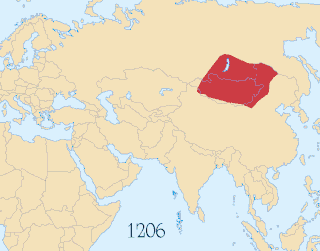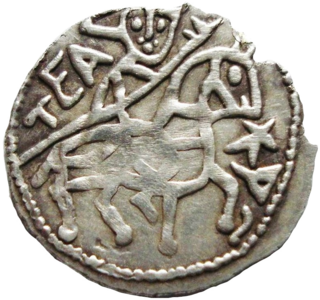
The Golden Horde, self-designated as Ulug Ulus, was originally a Mongol and later Turkicized khanate established in the 13th century and originating as the northwestern sector of the Mongol Empire. With the division of the Mongol Empire after 1259, it became a functionally separate khanate. It is also known as the Kipchak Khanate or the Ulus of Jochi, and replaced the earlier, less organized Cuman–Kipchak confederation.

The Mongol Empire of the 13th and 14th centuries was the largest contiguous empire in history. Originating in present-day Mongolia in East Asia, the Mongol Empire at its height stretched from the Sea of Japan to parts of Eastern Europe, extending northward into parts of the Arctic; eastward and southward into parts of the Indian subcontinent, mounted invasions of Southeast Asia, and conquered the Iranian Plateau; and reached westward as far as the Levant and the Carpathian Mountains.

Giyasuddin Muhammad Uzbek Khan, better known as Özbeg (1282–1341), was the longest-reigning khan of the Golden Horde (1313–1341), under whose rule the state reached its zenith. He was succeeded by his son Tini Beg. He was the son of Toghrilcha and grandson of Mengu-Timur, who had been khan of the Golden Horde from 1266 to 1280.

Kaidu was a grandson of the Mongol khagan Ögedei (1185–1241) and thus leader of the House of Ögedei and the de facto khan of the Chagatai Khanate, a division of the Mongol Empire. He ruled parts of modern-day Xinjiang and Central Asia during the 13th century, and actively opposed his uncle, Kublai, who established the Yuan dynasty. Medieval chroniclers often mistranslated Kadan as Kaidu, mistakenly placing Kaidu at the Battle of Legnica. Kadan was the brother of Güyük, and Kaidu's uncle.
Nogai, or Noğay was a general and kingmaker of the Golden Horde. His great grandfather was Jochi, son of Genghis Khan.
Amir Chūpān, also spelt Choban or Coban, was a Chupanid noble of the Ilkhanate, and nominal general of the Mongol Empire. He was ennobled by Emperor Taiding of Yuan as Duke of Yi (翊國公).

Chaka briefly reigned as tsar of Bulgaria, from 1299 to 1300. He was the son of the Mongol leader Nogai Khan by a wife named Alaka. Sometime after 1285 Chaka married a daughter of George Terter I of Bulgaria, named Elena. In the late 1290s, Chaka supported his father Nogai in a war against the legitimate khan of the Golden Horde, Toqta. Toqta defeated and killed Nogai in 1299.

Mengu-Timur or Möngke Temür was a son of Toqoqan Khan and Köchu Khatun of Oirat, the daughter of Toralchi Küregen and granddaughter of Qutuqa Beki. Mengu-Timur was a khan of the Golden Horde, a division of the Mongol Empire in 1266–1280.

The Berke–Hulagu war was fought between two Mongol leaders, Berke Khan of the Golden Horde and Hulagu Khan of the Ilkhanate. It was fought mostly in the Caucasus Mountains area in the 1260s after the destruction of Baghdad in 1258. The war overlaps with the Toluid Civil War in the Mongol Empire between two members of the Tolui family line, Kublai Khan and Ariq Böke, who both claimed the title of Great Khan (Khagan). Kublai allied with Hulagu, while Ariq Böke sided with Berke. Hulagu headed to Mongolia for the election of a new Khagan to succeed Möngke Khan, but the loss of the Battle of Ain Jalut to the Mamluks forced him to withdraw back to the Middle East. The Mamluk victory emboldened Berke to invade the Ilkhanate. The Berke–Hulagu war and the Toluid Civil War as well as the subsequent Kaidu–Kublai war marked a key moment in the fragmentation of the Mongol empire after the death of Möngke, the fourth Khan of the Mongol Empire.

As of 2020, Islam in Mongolia is practiced by approximately 5.4% of the population. It is practised by the ethnic Kazakhs of Bayan-Ölgii Province and Khovd Province aimag in western Mongolia. In addition, a number of small Kazakh communities can be found in various cities and towns spread throughout the country. Islam is also practiced by the smaller communities of Khotons and Uyghurs.

Öljaitü, also known as Mohammad-e Khodabandeh, was the eighth Ilkhanid dynasty ruler from 1304 to 1316 in Tabriz, Iran. His name 'Öjaitü' means 'blessed' in the Mongolian language and his last name 'Khodabandeh' means 'God's servant' in the Persian language.

A Byzantine-Mongol Alliance occurred during the end of the 13th and the beginning of the 14th century between the Byzantine Empire and the Mongol Empire. Byzantium attempted to maintain friendly relations with both the Golden Horde and the Ilkhanate realms, and was caught in the middle of growing conflict between the two. The alliance involved numerous exchanges of presents, military collaboration and marital links, but dissolved in the middle of the 14th century.
Bayan was one of the most famous khans of White Horde. "Bayan" means "rich" and "buyan" means "good deed/act" in the Mongolian language.
The Qara'unas or Negüderi were the Mongols who settled in Afghanistan after moving from Turkestan and Mongolia.
The Wings of the Golden Horde were subdivisions of the Golden Horde in the 13th to 15th centuries CE. Jochi, the eldest son of the Mongol Empire founder Genghis Khan, had several sons who inherited Jochi's dominions as fiefs under the rule of two of the brothers, Batu Khan and the elder Orda Khan who agreed that Batu enjoyed primacy as the supreme khan of the Golden Horde.
The division of the Mongol Empire began after Möngke Khan died in 1259 in the siege of Diaoyu Castle with no declared successor, precipitating infighting between members of the Tolui family line for the title of khagan that escalated into the Toluid Civil War. This civil war, along with the Berke–Hulagu war and the subsequent Kaidu–Kublai war, greatly weakened the authority of the great khan over the entirety of the Mongol Empire, and the empire fractured into four khanates: the Golden Horde in Eastern Europe, the Chagatai Khanate in Central Asia, the Ilkhanate in Iran, and the Yuan dynasty in China based in modern-day Beijing – although the Yuan emperors held the nominal title of khagan of the empire.

The Yuan dynasty in Inner Asia was the domination of the Yuan dynasty in Inner Asia in the 13th and the 14th centuries. The Borjigin rulers of the Yuan came from the Mongolian steppe, and the Mongols under Kublai Khan established the Yuan dynasty (1271–1368) based in Khanbaliq. The Yuan was a dynasty that incorporated many aspects of Mongol and Chinese political and military institutions.

Kaidu, the leader of the Mongol House of Ögedei, fought a war against Kublai Khan and his successor Temür from 1268 to 1301. Kaidu was the de facto khan of the Chagatai Khanate, while Kublai was the founder of the Yuan dynasty. The Kaidu–Kublai war followed the Toluid Civil War (1260–1264) and resulted in the permanent division of the Mongol Empire. By the time of Kublai's death in 1294, the Mongol Empire had fractured into four separate polities: the Golden Horde khanate in the northwest, the Chagatai Khanate in the middle, the Ilkhanate in the southwest, and the Yuan dynasty in the east based in modern-day Beijing. Although Temür later made peace with the three western khanates in 1304 after Kaidu's death, the four successor states of the Mongol Empire continued their own separate development and fell at different times.

The Esen Buqa–Ayurbarwada war was a war between the Chagatai Khanate under Esen Buqa I and the Yuan dynasty under Ayurbarwada Buyantu Khan and its ally the Ilkhanate under Öljaitü. The war ended with the victory for the Yuan and the Ilkhanate, but the peace only came after the death of Esen Buqa in 1318.














